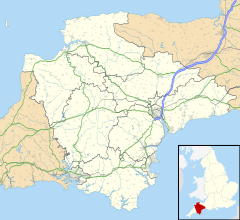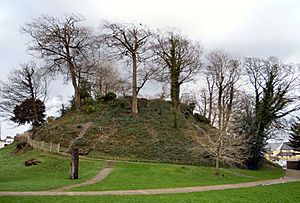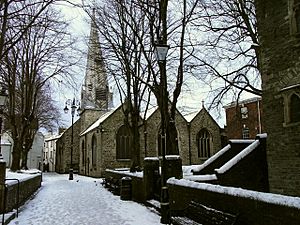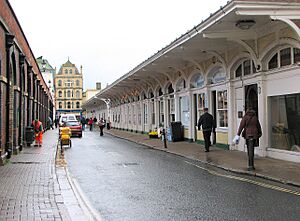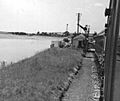Barnstaple facts for kids
Quick facts for kids Barnstaple |
|
|---|---|
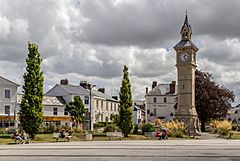 Barnstaple Clock Tower |
|
 Coat of arms |
|
| Population | 23,976 (Parish, 2021) 31,275 (Built up area, 2021) |
| OS grid reference | SS5633 |
| Civil parish |
|
| District |
|
| Shire county | |
| Region | |
| Country | England |
| Sovereign state | United Kingdom |
| Post town | BARNSTAPLE |
| Postcode district | EX31, EX32 |
| Dialling code | 01271 |
| Police | Devon and Cornwall |
| Fire | Devon and Somerset |
| Ambulance | South Western |
| EU Parliament | South West England |
| UK Parliament |
|
Barnstaple is a town in Devon, England. It's a river-port town located on the River Taw, close to where it meets the Bristol Channel. For a long time, starting in the 1300s, Barnstaple was allowed to export wool. This made the town very rich.
Later, the town started importing wool from Ireland. But the harbour began to fill up with mud, making it hard for big ships to get through. So, other jobs became important, like building ships, making metal goods, and cutting wood. Today, you can still see a beautiful old market building from the Victorian era, with a tall glass and wooden roof.
Contents
- What's in a Name?
- A Look Back in Time
- How Barnstaple is Run
- Where is Barnstaple?
- People in Barnstaple
- Money and Jobs
- Town Friends Around the World
- Cool Places to See
- Getting Around
- Learning in Barnstaple
- Churches and Other Religious Places
- Local News and Entertainment
- Sports in Barnstaple
- Famous People from Barnstaple
- Images for kids
- See also
What's in a Name?
The name Barnstaple was first written down in the 900s. People think it comes from old English words. Bearde meant "battle-axe," and stapol meant "pillar." So, it might have been a special post or pillar that marked a meeting place for religious or official reasons.
Some people thought the name came from "staple," meaning "market." But this is probably wrong because the word "staple" for a market didn't appear until much later, in 1423.
Barnstaple used to be called "Barum." This was a shorter version of its Latin name, ad Barnastapolitum, used in old Latin papers. The spelling Barnstable was also used, but it's not used for the town anymore. However, a town and county in Massachusetts, USA, are still called Barnstable because they were named after this English town.
The old name "Barum" became popular again in the Victorian times because of some novels. You can still see it today in the names of a football team, a brewery, and other businesses. An old pottery in the town, Brannam Pottery, even used "Barum" as its special mark on its products.
A Look Back in Time
The very first settlement in this area was probably at a place called Pilton, which is now a northern part of Barnstaple. Pilton was an old fortified town built by Alfred the Great around 917 AD. It might have been attacked by Vikings in 893. But by the late 900s, Barnstaple became the main place for local defence. It even had its own mint (where coins were made) before the Normans arrived.
After William the Conqueror took over England, he gave the land around Barnstaple to a lord named Geoffrey de Montbray. This land was called the "feudal barony of Barnstaple." Later, the land passed to another lord, Juhel de Totnes. Around 1107, Juhel started a religious house called Barnstaple Priory.
A market was first officially recorded in Barnstaple in 1274. The town became very rich in the Middle Ages because it was a "staple port." This meant it was a special port allowed to export wool. It also had an early group of merchants called the guild of St Nicholas. In the early 1300s, Barnstaple was the third richest town in Devon, after Exeter and Plymouth. It was also the biggest place for making textiles (cloth) outside of Exeter until about 1600.
The wool trade was helped by its port. In 1588, when England fought the Spanish Armada, Barnstaple sent five ships to help. The town was also one of the special ports for the Spanish Company, which was a trading group. You can see their symbols on old monuments in St Peter's Church.
In the 1500s and 1600s, Barnstaple became even richer from trade with America. Wealthy merchants built impressive houses. Some of these old houses still exist today behind newer fronts. These merchants also built almshouses (homes for poor people) and had fancy family monuments in the church.
By the 1700s, Barnstaple stopped being a major wool-making town. Wool started coming from Ireland instead, and Barnstaple became the main place where it landed. The raw wool was then taken to other towns like Tiverton and Honiton to be made into cloth. However, the harbour was getting filled with mud, making it harder for ships to use. Another town, Bideford, which was further down the river, slowly took over the trade.
Even though Bideford became more important for trade between 1680 and 1730, Barnstaple still had an important economy into the early 1900s. It made things like lace, gloves, sail-cloth, and fishing nets. There were also many potteries, leather factories, sawmills, and metal foundries. Some shipbuilding still happened too.
Between the 1930s and 1950s, Barnstaple grew bigger. It included nearby villages like Pilton, Newport, and Roundswell as new houses and buildings were built along the roads.
How Barnstaple is Run
Barnstaple has three levels of local government:
- Barnstaple Town Council: This is the local council for the town itself. It meets at the Guildhall on High Street.
- North Devon Council: This council covers the wider North Devon area. Its offices are just outside Barnstaple.
- Devon County Council: This council covers the whole county of Devon. Its main office is in Exeter.
Town's History of Governance
Barnstaple has been a special town with its own rules for a very long time. In 1340, the town's guild (a group of merchants) said that King Athelstan had given them a special charter (a document granting rights) in 930. This charter was supposedly lost. The town was called a "borough" in the Domesday Book of 1086. By 1210, a guild was running the town and choosing a mayor.
However, the lord of the land around Barnstaple disagreed. He said the town was a "mesne borough," meaning it answered to him, not directly to the king. So, the king didn't recognize the mayor as an official mayor, but just as the lord's bailiff (an official). The town tried many times to get a charter directly from the king, but they didn't succeed for a long time. Some of the charters they claimed were actually fake, copied from Exeter's charters!
Finally, in 1557, Queen Mary I gave Barnstaple a real charter. This allowed the town to officially govern itself. The council built the Guildhall in 1828 for their meetings. In 1836, the town's boundaries were made bigger to include parts of Pilton and Newport. They were made even bigger in 1899.
In 1974, the old borough of Barnstaple was ended. Its area joined with other areas to form the new district of North Devon. A new council, called Barnstaple Town Council, was created for the old borough area. The Town Council now has its offices at Barum House, but still uses the Guildhall for meetings.
Members of Parliament
From 1295, Barnstaple had two members in the British House of Commons. This was reduced to one in 1885. In 1950, the Barnstaple area became part of the larger North Devon constituency. This area has been represented by different political parties over the years.
Where is Barnstaple?
Barnstaple is the biggest town in North Devon. It is about 68 miles (110 km) west-south-west of Bristol. It's also about 50 miles (80 km) north of Plymouth and 34 miles (55 km) north-west of Exeter, which is the main city of Devon.
The town was built at the lowest point where you could cross the River Taw. This is about 7 miles (11 km) inland from Barnstaple Bay in the Bristol Channel. On the north side of the Taw, another river called the River Yeo joins it.
Most of Barnstaple is on the east side of the river. It's connected to the west side by the very old Barnstaple Long Bridge, which has 16 arches. The way the streets are laid out today still shows how the town looked in medieval times. For example, Boutport Street ("About the Port") follows the curved line of an old ditch that was outside the town walls. The area where ships used to be built and repaired is still called The Strand, which is an old word for a shore.
Weather in Barnstaple
Barnstaple has cool, wet winters and mild, wet summers. The average high temperature is around 9°C (48°F) in January and 21°C (70°F) in July. The hottest temperature ever recorded was 34°C (94°F), and the coldest was -9°C (16°F). October is usually the wettest month. On average, Barnstaple gets about 862 mm (33.9 inches) of rain each year, with rain falling on about 138 days.
People in Barnstaple
In 1801, the population of Barnstaple parish was 3,748. By 1901, it had grown to 9,698. In 2001, the population was 22,497.
In 2011, most people in Barnstaple were White British (77.9%). The town also has people from other backgrounds, including other White groups (2.6%), mixed race (2.2%), Asian (1.6%), and Black (14.3%). This makes Barnstaple more diverse than the wider North Devon area or Devon as a whole.
Money and Jobs
North Devon is quite far from the main industrial and populated areas of Britain. In the late 1970s, some factories moved here because the government offered money and tax breaks. However, many of these businesses didn't last long after the grants ended. One success story was Cox Pharmaceuticals (now Allergan), which makes medicines and moved to Barnstaple in 1980. This led to the growth of industrial areas in the town.
When the A361 road was improved in 1989, it made it easier for tourists to visit on weekends. But it also meant that some delivery businesses no longer needed to be based in Barnstaple, as it became quicker to travel from other places.
Barnstaple is the main shopping area for North Devon, so many people work in retail. You can find big chain stores in the town centre and at Roundswell Business Park. A large new development is also being built at Anchorwood Bank, with new homes, shops, restaurants, and places for fun.
The biggest employers in the area are local and national government, especially the Royal Marines Base Chivenor, which is about 3 miles (5 km) west of town. The North Devon District Hospital is also a major employer.
In 2018, unemployment in North Devon was low, at 1.2 percent. The average weekly pay for full-time workers was £440, and average house prices were £230,000. The number of businesses in the area has also increased. In 2018, the government invested £83 million to improve the North Devon Link Road.
Town Friends Around the World
Barnstaple is "twinned" with several towns and cities in other countries. This means they have special friendly relationships and often visit each other.
- Barnstable, Massachusetts, United States
- Uelzen, Germany
- Trouville-sur-Mer, France
- Susa, Piedmont, Italy
- Harstad, Norway
Cool Places to See
Barnstaple has a mix of old and new buildings. You can see many buildings from the 1800s, but also some older parts and special old plaster ceilings. St Anne's Chapel is one of the most important old buildings that still stands. Queen Anne's Walk was built around 1708 as a place for merchants to trade. The Georgian Guildhall and the Pannier Market below it are also interesting. The museum has a unique "arts and crafts" look with special floors and a staircase made locally.
Barnstaple Castle
Barnstaple Castle was built in the 1000s or 1100s. It was first mentioned in the 1100s and might have been built by Juhel of Totnes. In the 1100s, stone buildings were added to the castle mound. In 1228, the king ordered that the castle walls should not be taller than 10 feet (3 meters). By 1274, the castle was starting to fall apart. In 1326, it was a ruin. Part of the castle walls even blew down in a storm in 1601.
St Anne's Chapel
St Anne's Chapel is a very old Gothic chapel. It was fixed up in 2012 and is now used as a community centre. It can hold about 60 people.
Pannier Market and Butchers' Row
Barnstaple has been a major market town for North Devon since Saxon times. To make the food market healthier, the Pannier Market was built in 1855–1856. It was designed by a local architect and has a tall glass and timber roof supported by iron columns. It is 107 yards (98 meters) long and runs along the whole length of Butchers' Row.
Market days are:
- Monday: Crafts and General items (April to December)
- Tuesday: General and Produce
- Wednesday: Arts, Collectables, and Books
- Thursday: Crafts and General
- Friday: General and Produce
- Saturday: General and Produce
Butchers' Row was built at the same time as the Pannier Market. It has ten shops with special stone pillars and iron supports for an overhanging roof. Today, only one shop is still a butcher's, but other shops still sell local farm goods. You can find a baker, a deli, fishmongers, a florist, and a greengrocer.
The Pannier Market and Butchers' Row have been protected as a Grade II listed building since 1951.
Other Places to See
- Albert Clock in The Square
- Museum of Barnstaple and North Devon
- Queen's Theatre
- Rock Park
- Tarka Trail – These paths for cycling and walking celebrate the novel Tarka the Otter.
- South West Coast Path – A long walking trail that goes through the town.
- Lynton & Barnstaple Railway, about 15 miles (24 km) away.
Getting Around
In 1989, the A361 North Devon Link Road was built. This road connects Barnstaple to the M5 motorway, which is about 40 miles (65 km) to the east. This made travel much faster.
Traffic in the town used to be very bad. But in May 2007, the Barnstaple Western Bypass opened. This new road helps traffic going towards Braunton and Ilfracombe avoid the town centre and the old bridge. It includes a 1.6-mile (2.6 km) new road and a 447-yard (409 m) long bridge. The town's main square was also redesigned, and The Strand was closed to cars. The A39, also called the Atlantic Highway, continues from the A361 towards Bideford and Cornwall.
Most of Barnstaple's bus services are run by Stagecoach South West and Filers. The main bus station is near Queen Street. You can also catch National Express coaches to bigger cities like London, Bristol, and Birmingham.
The closest airport is Exeter Airport.
Trains
Barnstaple railway station is the end of a train line from Exeter called the Tarka Line. This line is named after the famous otter from the book. The station is near the old Long Bridge, on the other side of the River Taw from the town centre.
Many other train stations in Barnstaple closed in the 1960s. The current station opened in 1854. It used to be called "Barnstaple Junction" when a branch line to Ilfracombe opened in 1874. But it went back to being just "Barnstaple" when that line closed in 1970. Now it's the end of the line and much smaller.
The Ilfracombe branch line used to cross the river into the town centre. There was a station called Barnstaple Quay near the Castle Mound. It closed in 1898 and was replaced by a nearby station called Barnstaple Town. This station was also the end of the narrow-gauge Lynton and Barnstaple Railway, which closed in 1935.
Another Barnstaple station, called Barnstaple (Victoria Road), opened in 1873 to the east of the town. It was part of a different railway company. It also closed in 1970.
Learning in Barnstaple
Barnstaple has several primary and secondary state schools, as well as a college for older students.
In 2012, 58 percent of students in Devon achieved 5 GCSEs with good grades (A* to C). The average for the UK was 59 percent.
| School Name | Type | 2008 | 2009 | 2010 | 2011 | 2012 | |
|---|---|---|---|---|---|---|---|
| The Park Community School | State | 38% | 44% | 45% | 47% | 54% | |
| Pilton Community College | State | 47% | 51% | 50% | 53% | 49% |
Petroc (which used to be North Devon College) is a college that offers many different courses for young people over 16. It teaches both practical skills and academic subjects to more than 3,000 students.
Churches and Other Religious Places
St Peter's Church is the main church for Barnstaple. Its oldest parts might be from the 1200s. The main parts of the church were built in 1318. The church has a very special spire, which some people say is the best of its kind in the country. Inside, you can see many monuments to wealthy merchants from the 1600s. The inside of the church was greatly changed and fixed up in the late 1800s.
Other religious buildings include St Anne's Chapel (a 1300s chapel, now a museum) in the churchyard. The Church of St Mary the Virgin in Pilton is from the 1200s. Holy Trinity was built in the 1840s and rebuilt in 1867 because its foundations weren't strong. It has a nice tower. The Roman Catholic Church of the Immaculate Conception is said to have been designed by a famous architect named Pugin. The church of St John the Baptist was built in the late 1800s in the Newport area. There is also a Baptist chapel from 1870.
Local News and Entertainment
You can get local news and TV shows from BBC South West and ITV West Country.
Barnstaple has several local radio stations:
- BBC Radio Devon on 94.8 FM
- Heart West on 96.2 FM
- The Voice on 107.8 FM
- Fresh FM, which is run by students from Petroc college on 87.7 FM.
The local newspapers are the North Devon Gazette and North Devon Journal.
Sports in Barnstaple
- Cricket is played at Barnstaple and Pilton.
- The association football (soccer) club Barnstaple Town F.C. has been at Mill Road since 1904.
- Rugby union is played at Barnstaple Rugby Football Club.
- The Tarka Leisuire Centre offers many sports, including squash.
- There are also bowling greens and tennis courts, including the Tarka Tennis Centre, which has six indoor courts.
- In 2010, a Cornish Pilot Gig Rowing Club started, bringing this sport to the town.
Famous People from Barnstaple
Many interesting people have connections to Barnstaple:
- Henry de Bracton (c. 1210 – c. 1258), a church leader and lawyer.
- John Gay (1685–1732), a famous poet and writer.
- Graham Gore (c. 1809 – c. 1847), a naval officer and explorer who was lost on a polar expedition.
- Francis Carruthers Gould (1844–1925), a caricaturist and cartoonist.
- Caleb Simper (1856–1942), an organist and composer.
- Hubert Bath (1883–1945), who composed music for many films.
- Francis Chichester (1901–1972), a pioneering pilot and solo sailor.
- Jeremy Thorpe (1929–2014), a political leader who was an MP for North Devon.
- Johnny Kingdom (1939–2018), a wildlife filmmaker and photographer.
- John Keay (born 1941), a historian and radio presenter.
- Richard Eyre (born 1943), a director for film, theatre, and TV.
- Snowy White (born 1948), a guitarist who played with the rock band Thin Lizzy.
- Tim Wonnacott (born 1951), an antiques expert and TV presenter.
- David Spiegelhalter (born 1953), a statistician.
- Dermot Murnaghan (born 1957), a Sky News TV presenter.
- Phil Vickery (born 1976), a rugby player and former England captain.
- Stuart Brennan (born 1982), a BAFTA-winning actor.
- George Friend (born 1987), a professional footballer.
- Andy King (born 1988), a professional footballer.
Images for kids
See also
 In Spanish: Barnstaple para niños
In Spanish: Barnstaple para niños


